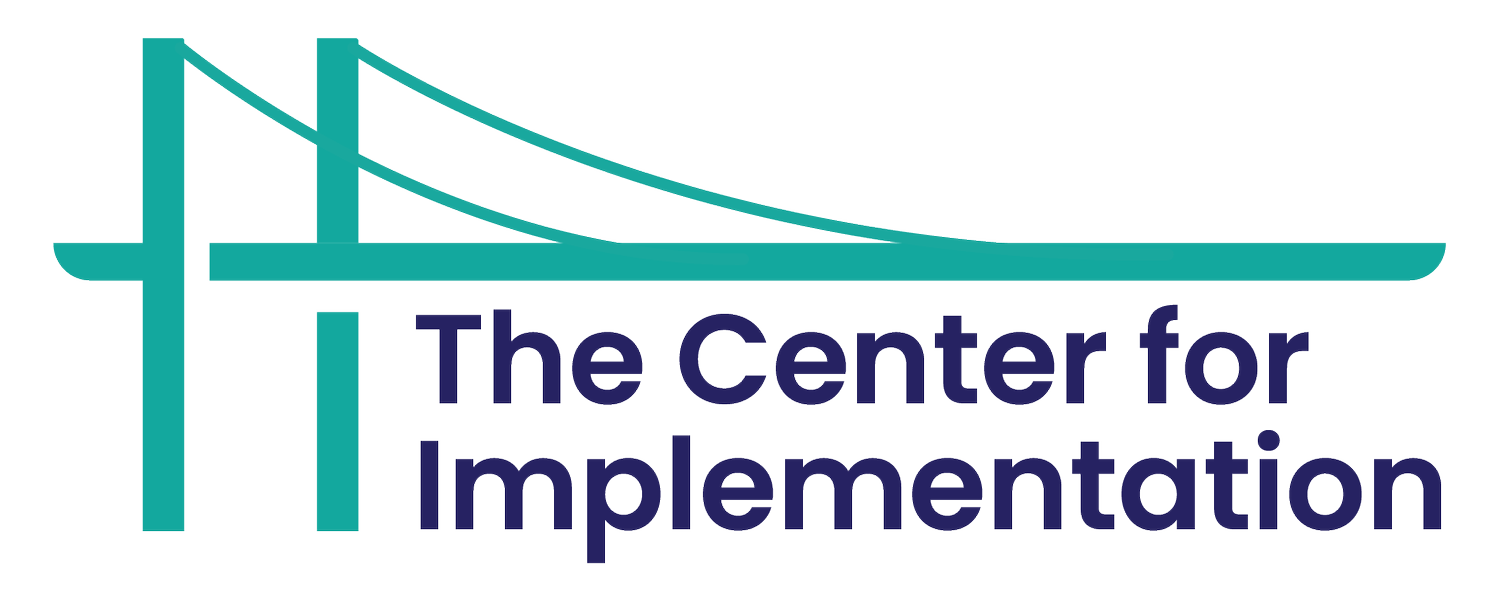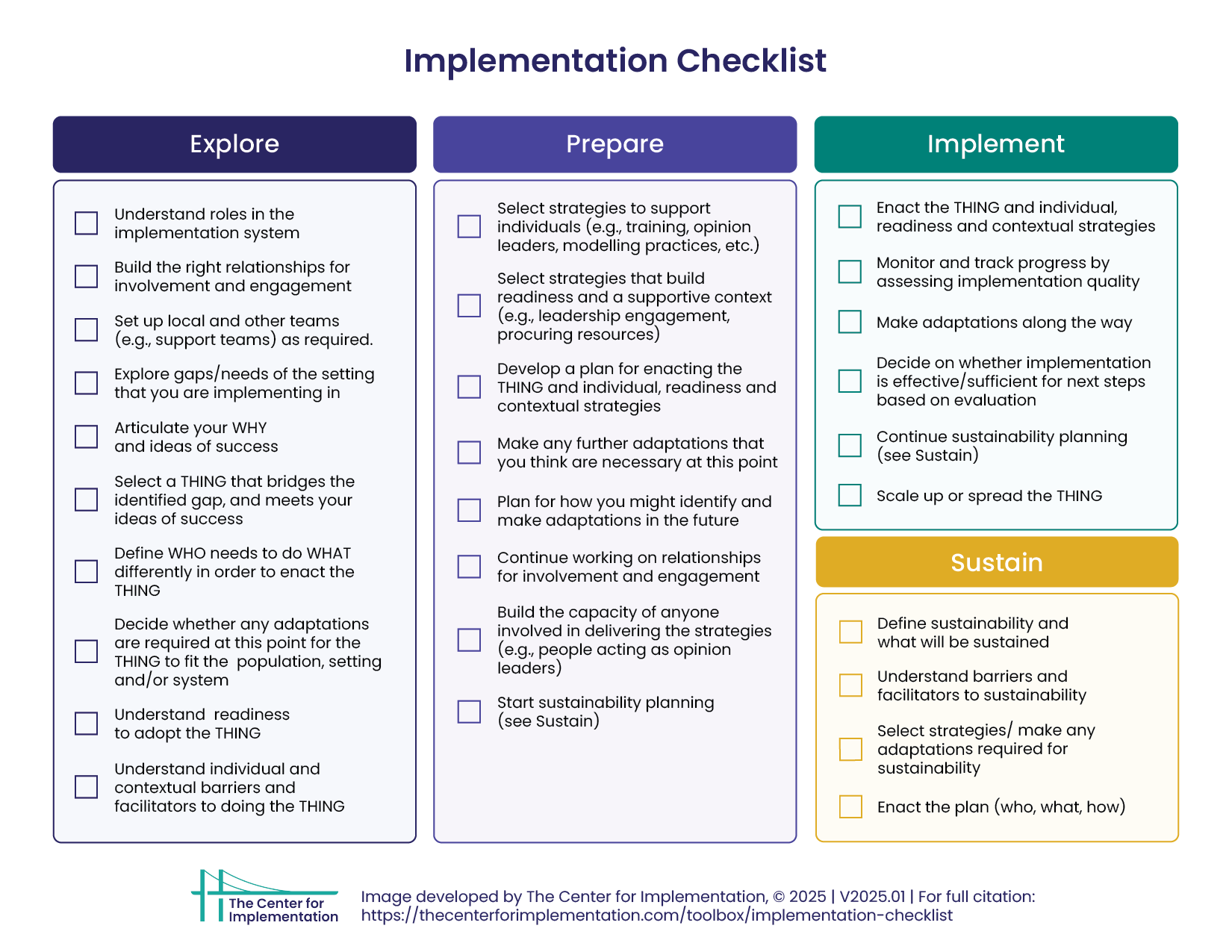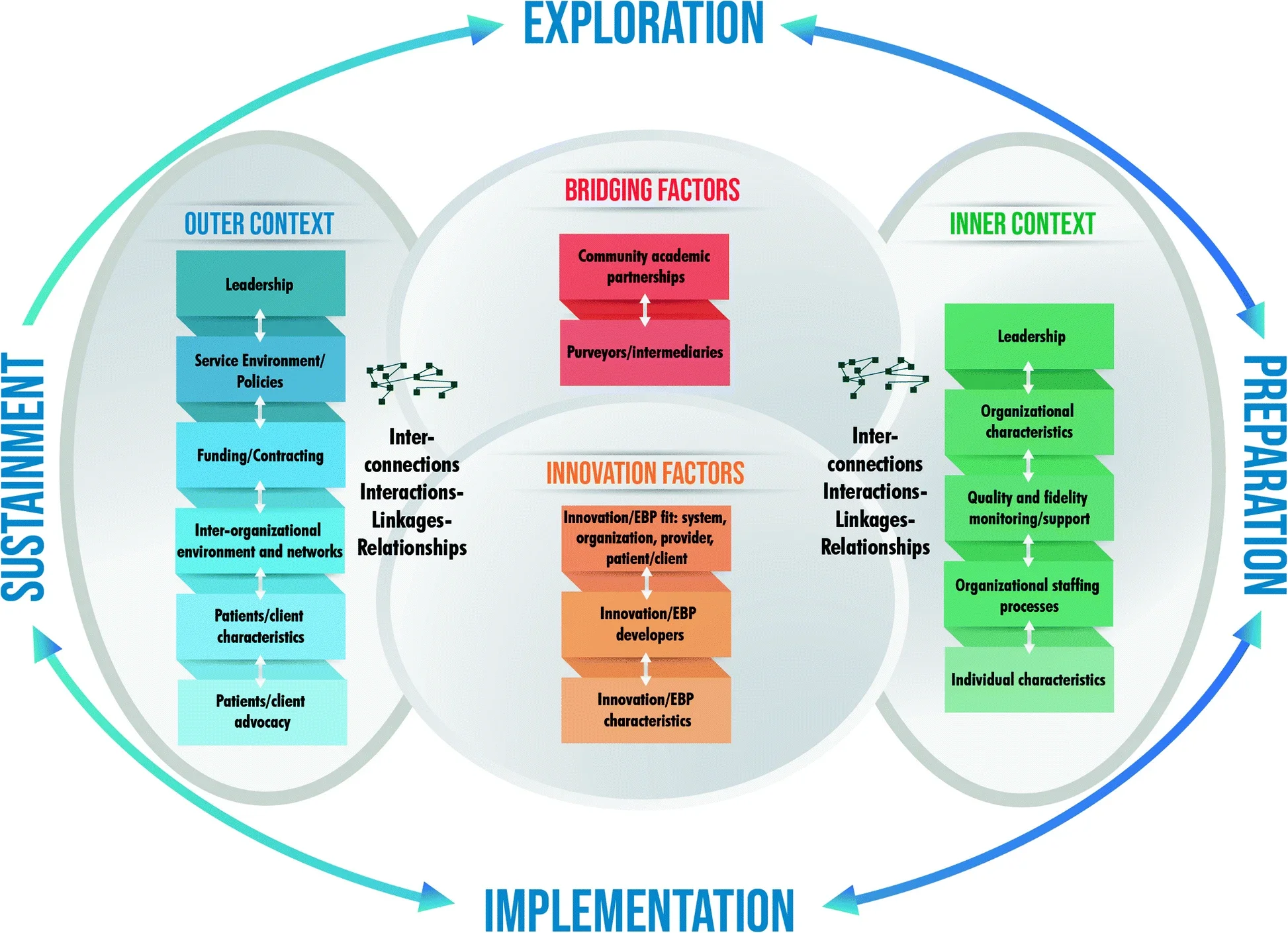Breaking Down the Implementation Plan: Practical Tips for Real-World Success
By Dr. Sobia Khan, Director of Implementation
5-min read
Creating an implementation plan can feel overwhelming — even for experienced teams. At The Center for Implementation (TCI), we’ve learned that building an effective implementation plan isn’t about finding the perfect template but about embracing the complexity of real-world change.
In this post, we share practical insights and tips to help you strengthen your implementation planning process.
My personal reflections on this topic are that we can learn a lot about how to implement, but putting this information into something coherent, concrete, and action-oriented is challenging because implementation is complex.
We love one-page templates that incorporate all of the information we want and need, which we complete once to declare that “we have a plan!” Real implementation planning involves planning for plans, and then developing multiple plans, and then revisiting and revising those plans often. They are never clean, and anyone who can fit a plan on one page deserves a Nobel prize. I have learned that it’s okay to have messy plans, because only when you have a messy plan can you truly understand the nature of implementation.
At TCI, we have dabbled in what people tend to do when trying to make sense of complex implementation plans: we have developed templates and a handy little checklist.
Critics of templates and checklists who come from the paradigm of complexity science will say that this is the human way of simplifying complex things to make them easier for our brains to deal with, and that templates and checklists don’t do complexity justice. While I agree, in practice, we need something tangible to work with to help us make planning more concrete, and what matters is the mindset and processes that we approach implementation planning with. Here, I share a few tips.
Tip #1: Take a bird’s eye view of your implementation plan
Implementation involves “planning for plans”. Often, when planning for implementation, you are not just planning for the implementation phase (i.e., when you start rolling out your initiative) – you plan for many activities pre-implementation, during implementation, and post-implementation. Because of this, we decided to develop the Implementation Checklist based on the Exploration-Preparation-Implementation-Sustainment (EPIS) Framework, consolidating activities and steps from multiple implementation process models into the framework components.
Moullin, J.C., Dickson, K.S., Stadnick, N.A. et al. Systematic review of the Exploration, Preparation, Implementation, Sustainment (EPIS) framework. Implementation Sci 14, 1 (2019). https://doi.org/10.1186/s13012-018-0842-6
The idea behind the Implementation Checklist is that there are many activities that you can plan to do within each stage of implementation that will help prepare you for the next stage. All of these stages are important (not just the implementation stage) and it helps your team to consider that you may have to plan for activities before implementation (exploration and preparation – e.g., making adaptation plans, a plan for how you will select implementation strategies, a plan for capacity building in settings, etc.); implementation (e.g., the number and length of each implementation cycle, a monitoring and evaluation plan, a plan to make additional adaptations); and sustainment (e.g., making a sustainability plan).
We like to use the Implementation Checklist to track what activities we have done, but also to help us think through the things we need to plan for so that we can make a list of plans we require.
Why this matters:
When teams focus only on initial implementation, they overlook critical pre-implementation/readiness and sustainability planning activities. Considering the full implementation process helps you anticipate challenges, prepare for transitions, and build long-term success into your plan.
Tip #2: Design implementation plans to be iterative and flexible
Many templates for plans are in tabular form, which makes sense to help organize a lot of information. This can also make plans feel somewhat rigid and static when we know they change.
We recently encountered this when developing a new adaptation planning tool for our upcoming Context at Scale course. Our solution was to build in processes of completing these templates that honor iteration and can track iteration over time – for example, adding tabs and changing the template over time as required.
It’s difficult to escape a tabular world and I am the first to admit that I often think in tables, but how we approach and handle the information in the tables is the vital part of the process that is overlooked.
Why this matters:
Implementation rarely goes as planned. Building in iteration lets you adapt to emerging insights, context shifts, and end-user feedback — turning your implementation plan into a living, learning tool instead of a static document.
Tip #3: Create internal and external versions of your implementation plan
One reason why people shy away from messiness in plans is that they often want to share their plans with others. We encourage people to have external and internal plans to mitigate this concern.
External plans have been cleaned up and are fit for circulation. Perhaps they are not as detailed, and they keep the external user in mind.
Internal plans are the messy and iterative ones, and help your team do all of the sense-making work that is required to make progress.
Why this matters:
Different audiences need different levels of detail. Maintaining an internal and external plan helps your team stay organized and transparent without compromising the nuance and complexity of your real work (just as many teams do with multiple versions of a logic model).
Tip #4: Embrace uncertainty in implementation planning
Because implementation is often complex, we know we can’t possibly plan for everything we may encounter because there is so much uncertainty in the process. Approaching planning with a mindset that you can’t plan for everything but will figure it out as things happen will save you a lot of emotional and psychological turmoil in the long term.
There are likely many other ways to approach an implementation plan that we hope to continue to explore and communicate with you. Hopefully, these tips have been helpful as you consider how to move forward with your planning work.
Why this matters:
You can’t plan for every possibility in complex systems — and that’s okay. Accepting uncertainty frees your team to focus on learning, adapting, and making informed decisions as new information emerges.
Final thoughts: Implementation planning is an ongoing process
Implementation planning isn’t about creating the perfect checklist—it’s about creating clarity in complexity and chaos. The more you embrace iteration, multiple plans, and the reality that things will shift, the stronger your implementation efforts become.
If you’d like to deepen your skills in implementation planning, explore our Implementation Checklist and TCI resources or check out our courses – the course quiz is a great way to find the right course for you.
This article was featured in our monthly Implementation in Action bulletin! Want to receive our next issue? Subscribe here.


